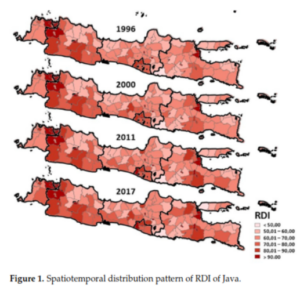Spatiotemporal Distribution Patterns and Local Driving Factors of Regional Development in Java

Author: Andrea Emma Pravitasari, Ernan Rustiadi, Rista Ardy Priatama, Alfin Murtadho, Adib Ahmad Kurnia, Setyardi Pratika Mulya, Izuru Saizen, Candraningratri Ekaputri Widodo, and Siti Wulandari.
Abstract: Although uneven regional development has long been an issue in Java, most parts of the territory experienced an increased level of development over the last two decades. Due to the variance in local background and spatial heterogeneity, the driving factors of the development level should, theoretically, vary over space. Therefore, in this study, we aim to investigate the local factors that influence the development level of Java’s regions. We used the spatiotemporal pattern analysis, ordinary least squares (OLS) regression, and geographically weighted regression (GWR), utilizing the regional development index as the predicted variable, and the social level, economy, infrastructure, land use, and environmental barriers as predictors. As per our results, it was found that the level of development in Java has improved over the past two decades. Metropolitan areas continued to lead this improvement. All the predictors that we examined significantly affected regional development. However, the spatial pattern of the local regression coefficients of Human Development Index (HDI), landslide, paddy conversion, and crime shifted due to changes in the spatial concentration of development activities.
Keywords: carrying capacity; regional development; spatial analysis
Journal URL: https://www.mdpi.com/2220-9964/10/12/812

 English
English